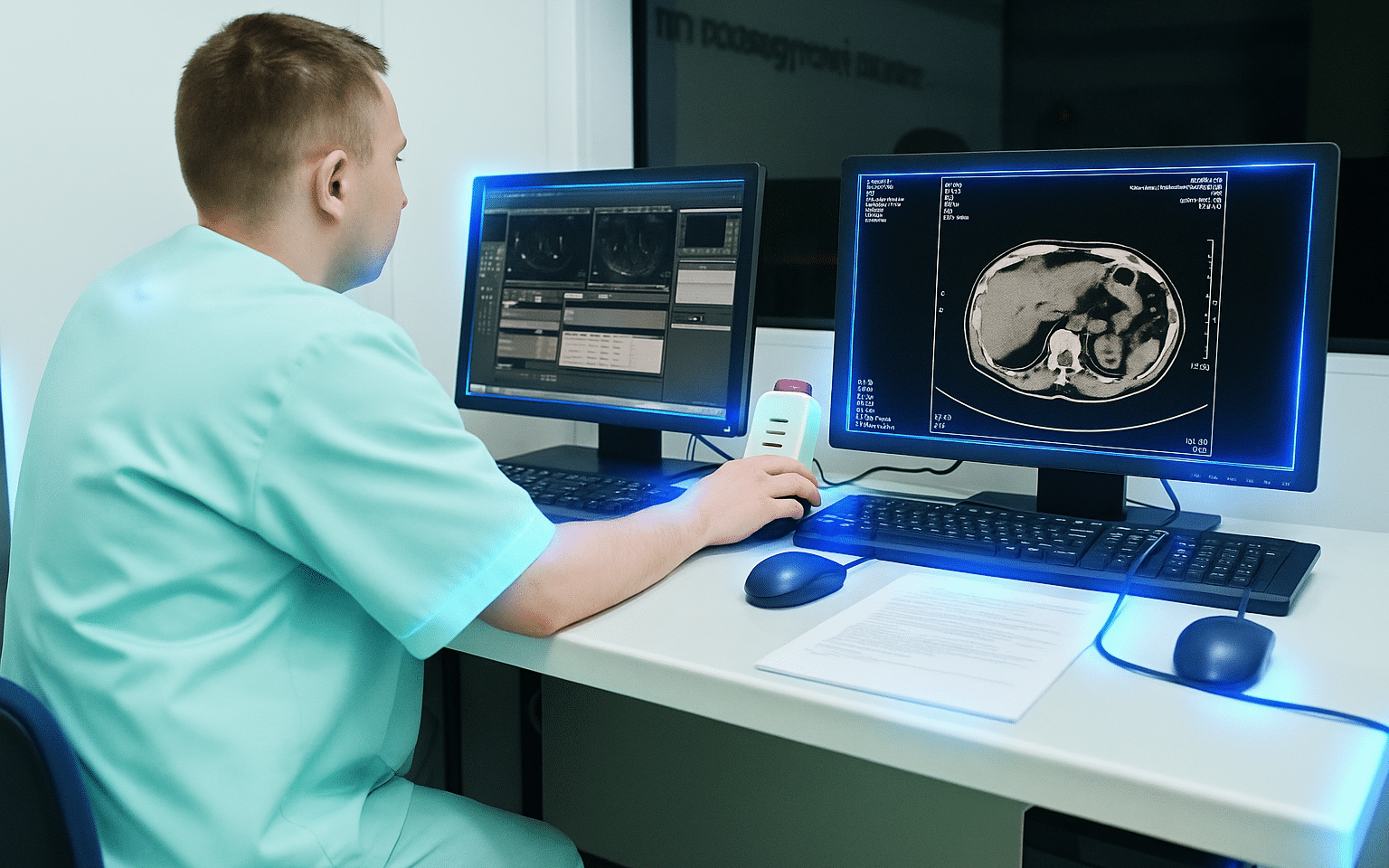
Jump to a section:
At Emulent, we’ve worked alongside various healthcare organizations, and we’ve seen just how pivotal diagnostic imaging centers can be. From MRI and CT scans to ultrasounds and X-rays, your services are essential for accurate patient diagnoses and streamlined treatment plans. Yet, despite this critical role in healthcare, many imaging centers struggle to establish a strong brand identity, attract consistent referrals, and stand out in a crowded field.
1. Define Your Unique Value Proposition (UVP)
Clarify What Sets You Apart
Some imaging centers focus on advanced technology—like cutting-edge 3T MRI machines—while others excel at patient comfort, delivering fast appointments, or offering specialized scans (e.g., for cardiac imaging or pediatric patients). Regardless of your focus, pin down the core benefit you bring to both physicians and patients:
- Top-of-the-Line Equipment: Emphasize how state-of-the-art machines produce higher-quality images, reduce scan times, or enhance patient comfort.
- Specialized Expertise: If your radiologists or technologists hold advanced certifications, highlight that skill set. It fosters confidence in your diagnoses.
- Convenient Patient Experience: Maybe you offer flexible hours, same-day scheduling, or easy online results access—elements that simplify the lives of busy patients and referring clinics.
Tip: Weave this UVP into your website copy, social media, and even your email signatures, ensuring consistent brand messaging across all platforms.
2. Build a Credible Online Presence
Polish Your Website
Your site is often the first place referring physicians or prospective patients land. Make it polished, professional, and user-friendly:
- Services Pages: Dedicate a separate page to each modality (MRI, CT, ultrasound, etc.). Include technology details, benefits (e.g., low-dose radiation), and prep instructions for patients.
- About Us & Credentials: Highlight your radiologists’ qualifications, certifications, and any awards or affiliations (ACR accreditation, for example). This reassures visitors of your legitimacy and excellence.
- Patient Resources: Offer downloadable forms, FAQs about how to prepare for scans, and step-by-step instructions from check-in to results. The more transparent you are, the more confident patients feel.
- Online Scheduling or Referral Portal: If feasible, integrate a system allowing physicians or patients to schedule appointments directly on your site. Simplifying scheduling can dramatically reduce friction.
Remember to make the site mobile-friendly; busy physicians or caretakers may browse on their phones, and a clunky mobile layout could deter them from referring or booking your services.
Leverage Local SEO
When patients (or even providers) search “diagnostic imaging near me” or “MRI center in [City],” you want to appear in the top results. Invest in local SEO fundamentals:
- Optimize Google Business Profile: Add accurate address info, business hours, and relevant images of your facility. Encourage satisfied patients or partnering physicians to leave reviews.
- Citations & Consistency: List the same Name, Address, and Phone (NAP) details on all directories—like Healthgrades or Vitals—so search engines see consistent info.
- Location-Focused Content: Include references to your city or region in meta tags, page titles, and blog posts, possibly pairing them with specific services (e.g., “High-Resolution CT Scans in [City], State”).
Local visibility ensures that prospective patients and doctors discover you when actively seeking imaging solutions in the area, leading to more inbound leads and referrals.
3. Cultivate Physician and Provider Relationships
Physician Outreach
Though patients can sometimes self-refer, many imaging appointments come via physician recommendations. Nurturing those relationships is crucial:
- Dedicated Physician Liaison: Designate a point-person who visits local clinics, specialist offices, or hospitals. Share updates about new equipment, faster turnaround times, or additional reading capabilities.
- Lunch & Learn Sessions: Offer brief educational presentations for medical staff—perhaps explaining the advantages of a new MRI coil or how your radiologists interpret images in certain specialties. Bringing lunch can increase attendance and goodwill.
- Fast Report Turnaround & Easy Access: Provide a secure portal where doctors can quickly retrieve and view patient scans and reports. Emphasize your average turnaround times in your marketing materials.
Building a reputation for reliability, clear communication, and top-tier imaging fosters repeat referrals. Physicians want to trust that their patients will have a positive experience—and that they’ll receive accurate, timely results.
Sponsorships and Industry Events
Networking within the local medical community can yield ongoing referral streams:
- Sponsor Medical Society Gatherings: If your area has a county medical association or specialty groups (like orthopedics or cardiology), consider sponsoring a meeting. This gets your brand in front of a niche group that frequently needs imaging.
- Attend Healthcare Fairs & Expos: Set up a booth showcasing your facility’s features, advanced imaging tech, or patient-friendly services. Bring staff who can answer specific queries from doctors or administrators.
- Host Open House Events: Invite local doctors for a tour of your center. Demonstrate new equipment, discuss your reading capabilities, and highlight how easy it is to refer patients. A behind-the-scenes peek fosters familiarity and trust.
Tip: Encourage staff to be approachable and well-informed. A personable interaction with your team can have a lasting positive impression on potential referral sources.
4. Showcase Technology and Expertise
Highlight Advanced Imaging Techniques
Diagnostic imaging often hinges on the latest hardware and software solutions. If you boast a brand-new 3D mammography system, an ultrafast CT scanner, or specialized MRI for musculoskeletal imaging, let prospects know:
- Equipment Spotlights: Dedicate a page or blog post to each advanced machine, explaining how it improves diagnostic accuracy, reduces patient discomfort, or speeds up scanning times.
- Before-and-After Comparisons: For instance, show how a high-resolution MRI scan can detect small lesions that might be missed by older systems. Real examples can clarify the difference advanced tech makes.
- Video Tours: A short video of the scanner room can demystify the process, calm anxious patients, and demonstrate a modern, professional setting.
This emphasis on state-of-the-art tools can differentiate you from a competitor still using older or less sophisticated machines, appealing to both doctors seeking precise results and patients craving comfort.
Introduce Your Radiologists and Staff
Patients entrust your team with critical tests that inform major health decisions. By humanizing your experts, you alleviate patient anxiety and strengthen relationships:
- Staff Bios: Provide short profiles of your radiologists, technologists, or any subspecialists, noting their credentials, years of experience, or any academic achievements.
- Team Photos: Show the faces behind your service. A friendly group shot or short staff videos can project warmth, making patients feel more at ease about visiting.
- Community Involvement: If your radiologist volunteers at health fairs or your center sponsors local youth sports, share these anecdotes. It shows commitment to the broader community.
A approachable, expert team is more likely to earn trust and facilitate comfortable patient experiences—leading to repeat visits and referrals.
5. Offer a Patient-Centric Experience
Simplify Appointments and Communications
From nervous first-time patients to busy individuals juggling work and family, make every stage of interacting with your center as easy as possible:
- Online Scheduling: If feasible, allow patients to book imaging appointments via an online portal, complete with open time slots and automated reminders.
- Pre-Visit Prep Guides: Clearly explain how to prepare for different scans (e.g., fasting, removing metal objects) in easy-to-read PDF handouts or website pages. This reduces confusion and no-shows.
- Virtual Chat or Messaging: Implement a live chat feature or secure messaging so potential clients can ask quick questions about insurance coverage, wait times, or report availability.
When you reduce hassles, you show that your brand values patient well-being, not just the procedures. This level of care fosters positive word-of-mouth, especially in an industry where anxiety can run high.
Educate Patients with Friendly Content
Some individuals dread MRIs due to claustrophobia, others might be worried about radiation in CT scans. By proactively addressing concerns, you build confidence:
- Blog Articles: Write short, accessible posts: “What to Expect During an MRI,” “Is It Safe to Get Multiple X-Rays?” or “Top 5 Tips for Relaxing Before a Scan.”
- Downloadable FAQs: Provide a simple PDF that addresses common queries about sedation, contrast dyes, or insurance coverage. Encourage patients to read it before arrival.
- Videos: Quick animated explainers can show step-by-step how a machine works, the length of typical scans, and any noise or sensations a patient might encounter.
Calming potential fears not only improves the patient’s experience but also makes them more likely to complete future follow-ups—and recommend your center to friends dealing with similar imaging needs.
6. Foster Long-Term Relationships
Engage Repeat Patients and Physician Networks
Certain imaging needs—like mammograms or follow-up scans—can recur yearly or periodically. Similarly, some local physicians refer multiple patients monthly. Retain their loyalty by offering consistent, top-tier support:
- Email or Text Reminders: For repeat screenings like mammograms, an annual prompt or “it’s time for your check-up” message encourages patients to schedule again without you needing to do a full marketing push.
- Referring Physician Portals: A secure online system for doctors to track patient exam statuses or instantly view radiology reports can simplify their workflow. The convenience cements your center as their go-to referral partner.
- Thank-You Initiatives: Send hand-written notes or small tokens of appreciation to high-referring clinics or to loyal patients who’ve completed multiple scans. That personal touch stands out in a sometimes-impersonal healthcare environment.
Through consistent follow-up and considerate gestures, you transform single transactions into ongoing relationships—leading to a stable patient base and consistent referral pipeline.
7. Measure and Refine Your Marketing Efforts
Monitor Key Metrics
Tracking performance clarifies which campaigns yield strong results. Consider metrics like:
- Website Conversions: How many site visitors request an appointment or call your center? If conversion rates are low, maybe your CTAs or contact forms need tweaks.
- Referral Source Data: Are new patients citing Google searches, physician referrals, or social media promotions? Double down on channels that deliver quality leads.
- Patient Feedback & Satisfaction: Gather reviews or post-appointment surveys to see how people rate the booking process, staff friendliness, and the overall experience.
- Social Engagement: Track likes, comments, or shares on posts discussing new imaging technology or explaining test prep. High engagement indicates interest in that content direction.
Analyzing these insights guides you toward data-driven decisions. Over time, refining your website, marketing materials, and outreach channels can dramatically enhance brand awareness and patient flow.
Stay Adaptive and Up-to-Date
Diagnostic imaging continues to evolve—new machines, better software, changing guidelines, or insurance coverage shifts. Incorporate these developments into your marketing and brand communications:
- Announce Tech Upgrades: If you acquire a cutting-edge PET-CT or an AI-assisted analysis tool, broadcast the news on your site and social media, emphasizing how it benefits patient outcomes.
- Update Compliance and Safety Info: If new radiation safety standards or best practices emerge, clarify how you’re adopting them. Consistent updates build patient trust.
- Expand Content Themes: As telehealth or remote diagnostics gain traction, consider writing about how your center integrates with those trends or fosters seamless digital record-sharing.
By staying in tune with industry shifts and local healthcare needs, your brand remains relevant, pioneering, and worthy of continuous referrals from the medical community and satisfied patients alike.
Conclusion: Elevating Your Diagnostic Imaging Center’s Brand
Whether it’s an MRI, ultrasound, or advanced PET-CT scan, the work done by diagnostic imaging centers is crucial in modern healthcare. However, without a well-crafted brand identity and thoughtful marketing plan, potential referrers and patients might overlook your expertise. By focusing on your unique value proposition, polishing your online presence, strengthening physician relationships, and consistently refining the patient experience, you’ll set your center up as a trusted ally in the diagnostic pathway.
If you’re ready to sharpen your brand messaging and marketing strategy for robust growth, we’re here to help. Contact our Emulent team to discuss how to highlight your center’s unique services, embrace cutting-edge digital marketing, and position your diagnostic imaging brand for success in a competitive healthcare market.


